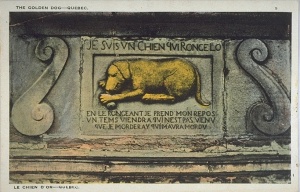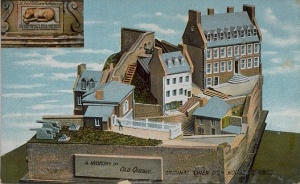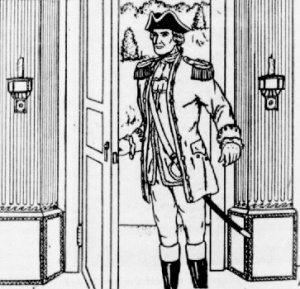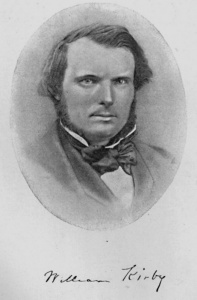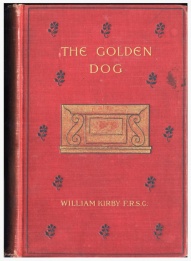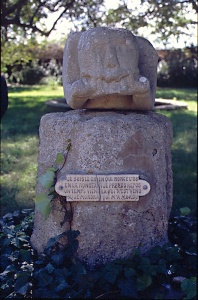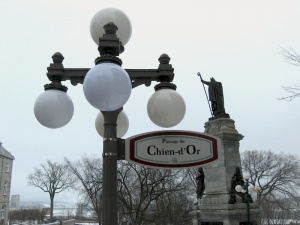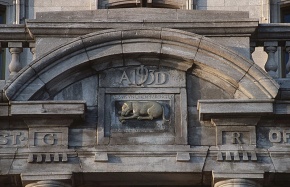
The Golden Dog
par Caron, Jean-François
In Passage du Chien d’Or, an alleyway near the top of the Côte de la Montagne in Quebec City, an enigmatic bas-relief adorns the pediment of the Louis S. St. Laurent building, the former main post office. It shows a golden dog gnawing on a bone with the following inscription: “Je suis un chien qui ronge lo / En le rongeant je prend mon repos / Un tems viendra qui nest pas venu / Que je morderay qui maura mordu” (I am a dog gnawing my bone / In so doing I rest alone / A time will come that’s yet to be / When I bite he who’s bitten me). This odd verse has given rise to a number of legends, all turning on the theme of revenge. Centuries have passed but the golden dog has maintained its hold on the collective imagination. It has been variously represented, appropriated, interpreted and reinterpreted, and slowly but surely carved out its niche as part of Quebec’s cultural heritage.
Article disponible en français : Le Chien d’Or
An Intriguing, Inspiring Architectural Flourish
The bas-relief has been a fixture since 1688. Every time the building it adorned was renovated or modified, care was taken to keep it in plain sight of passers-by at the same prime location in Quebec City’s upper town. The sculpture has always attracted curiosity and interest. Its renown has spread beyond Canada’s borders and it has acquired both widespread fame and special heritage value. The sculptor’s name may be unknown but there is no denying the intrinsic value of the over three-hundred-year-old work. Sculpted from Pointe-aux-Trembles limestone and in all likelihood gilded with gold leaf, the golden dog has stood the test of time, a stoic witness to the myriad events that have marked the history of this part of the city.
The Facts
In 1688 Timothée Roussel, a surgeon, had a house built on one of the lots he had purchased over the course of a decade on Buade Street. He then placed the soon to be famous bas-relief directly above his front door. Few of Roussel’s contemporaries seem to have been apprised of his motives, since no one was able to explain the bas-relief’s significance to John Knox, a British officer who inquired into the matter three generations later.
In 1734, several years after Roussel’s death, his heirs sold the lot and house to Nicolas Jacquin, a merchant better known as Philibert. When Philibert added a new central section to the house, he took care not to disturb the golden dog gnawing his bone. He did add a date stone marking the year of the addition, 1736.
Philibert went uneventfully about his business until January 20, 1748, when Pierre-Jean-Baptiste-François-Xavier Legardeur de Repentigny, a naval officer, showed up at his doorstep with a billet. (Private citizens at that time were compelled to house soldiers posted to Quebec, which did not yet have a barrack.) Philibert was not inclined to take Repentigny in and the discussion grew heated. When the merchant threatened the officer with his cane, the officer struck back with his sword and Philibert was mortally wounded. He drew his last breath the next day, having forgiven his killer. De Repentigny fled to Fort Saint Frédéric (today Crown Point in the state of New York). Two months later he was sentenced in absentia to be beheaded and to pay 8,000 pounds to Philibert’s widow. But in 1749 de Repentigny was pardoned in a letter signed at Versailles by Louis XV. He died on May 26, 1766, in Pondicherry, India.
Birth of a Canadian Legend
The drama of Philibert’s death might well have remained a footnote of history had it not been for the literary imagination of one William Kirby, a tanner, writer, journalist, teacher and civil servant who landed in Quebec City in July 1839. When Kirby discovered the bas-relief he searched in vain for someone able to explain its meaning. On a second journey to Quebec City in 1865 Kirby discovered a book called Maple Leaves, published two years earlier by Quebec City resident James McPherson Lemoine. This anthology contained texts on various subjects, including one about the golden dog. Kirby discussed the matter with his friend Benjamin Sulte, an archivist and historian of repute. Kirby enjoined Sulte to write the story of the golden dog, or else he would do so himself. Sulte took him at his word. Over the following years Kirby read up on the history of New France. He then wrote The Golden Dog, a popular novel based on three texts by McPherson Lemoine: “The Golden Dog,” of course, but also “Château Bigot” (actually the secondary residence built by Michel Bégon de La Picardière, Intendant of New France, in Charlesbourg in 1718), and “La Corriveau,” the legendary witch of Quebec folklore.
Kirby’s story features a slew of historical figures who had lived in or passed through Quebec City and is set against a historical background riddled with anachronisms. Two plotlines are intertwined. One tells the story of Angélique de Méloizes, Madame de Péan, who is in love with Sieur Le Gardeur de Repentigny but more inclined to marry Intendant Bigot for reasons of social status. Bigot, however, keeps a secret mistress at his Beaumanoir residence: Caroline de Saint-Castin, daughter of Baron of Saint-Castin, Abenaki chief. When Angélique de Méloizes finds out about her rival she grows jealous and enlists the help of La Corriveau, the witch, who agrees to go to Beaumanoir to take Méloizes’ rival captive. The other storyline follows Coronel Pierre Philibert—son of the prosperous merchant Nicolas Jacquin, known simply as Philibert—who is in love with De Repentigny’s sister. The aristocrat Bigot vies for the sister’s affections with the bourgeois Philibert, who stymies Bigot’s attempts to divert the colony’s funds into the coffers of the Grande Compagnie, of which he is principal shareholder. Bigot is further infuriated that Philibert has placed the bas-relief of the golden dog on the façade of his house, a deliberate provocation. He wants Philibert out of the way. To this end Bigot’s henchmen get De Repentigny drunk. When he meets Philibert on the way home a quarrel ensues and Philibert is killed. The incident clears the way for Philbert’s son Pierre to marry De Repentigny’s sister, but she dies of a broken heart at the Ursuline convent.
The first edition of The Golden Dog was published in New York in 1877. It was immediately popular. The first French translation, by Pamphile Lemay, did not appear until 1884–85, initially as a serial in the newspaper L'Étendard, then as a book in 1885. While there were many subsequent editions in both English and French, Kirby never became rich from his work because his publisher did not register his copyright.
Even today many people believe that Kirby’s novel is a true story. In fact it is just one of the many stories of the golden dog to appear over the years. These include John Knox’s account in his 1769 narrative of the siege of Quebec City; Reverend George Bourne’s 1829 version; Auguste Soulard’s rendering, published in Le Canadien in 1839; and the joint account of two Englishmen, Walter Beasant and James Rice, that appeared in 1879 (see a summary of interpretations). The story has also inspired artists in other disciplines: an opera was written and performed at Princeton University in 1929 and a comic strip by Paul Turcotte was featured in Quebec City’s Action Catholique between 1960 and 1961. A more recent retelling is Daniel Mativat’s 2003 young adult novel.
The True History
What does the true story of the bas-relief installed by Timothée Roussel have in common with the various legends it has inspired? Not much, according to the research carried out by sociologist Germaine Normand in the late 1990s.
In the 1670s and 1680s, Germaine Normand’s ancestor Jean Normand owned property in La Canardière on the road to Beauport. Timothée Roussel was his neighbour. The two men frequently bickered over right of passage. In 1682 the local Seigneur ordered Normand to give Roussel free passage over his land. Normand refused to comply. A quarrel ensued and Roussel appealed. The appeal was heard the following year and an investigator assigned to the case, but it did little good; Normand and Roussel came to blows. On April 1, 1686 the two men were finally summoned before the Sovereign Council. Normand was ordered to pay Roussel 60 pounds for injury and grant him free passage. In addition, both parties were fined 10 pounds. This fine would jump to 100 pounds each if the two again troubled the court. But there is another fascinating detail that made its way into the ruling: the judge advised Roussel to lodge an appeal against Normand’s son, Joseph, who had killed Roussel’s dog.
In 1916 the historian Benjamin Sulte discovered a sculpture in the round of a dog gnawing on a bone in Pézenas in the Languedoc-Roussillon region of France. A plaque at the base of the statue bears an inscription virtually identical to the one on the Quebec City golden dog bas-relief. Timothée Roussel was born around 1639 in the Mauguio Commune, a mere 66 km from the Pézenas Commune. The evidence thus suggests that around 1686 Joseph Normand killed Roussel’s dog, and that two years later Roussel affixed the golden dog bas-relief, with the quatrain promising revenge, to the façade of his home. Coincidence? While this theory cannot be proven beyond a reasonable doubt, it remains the most likely explanation of the origin of the bas-relief of the golden dog.
The Golden Dog Becomes a Heritage Icon
The golden dog bears witness to the transposition of a French legend onto Quebec soil. It has also inspired several artists, intellectuals, and businesspeople. Painters, poets novelists, librettists, merchants, historians—all have contributed to the golden dog’s renown. Their work has also sown confusion, tying the golden dog to an unrelated murder and creating the false impression that Charlesbourg’s Hermitage was the historical Chatêau Bigot.
Since 1829 the golden dog has been a fixture of Quebec City guidebooks. Over the years, it has inspired postcards and souvenir jewellery, dishes, and a host of other objects that partake, by association, of the golden dog’s symbolic significance: revenge. While not as famous as nearby Chatêau Frontenac, the golden dog has held its place in the collective imagination longer and remains a point of interest for visitors to Quebec City. Newspapers frequently mention this famous dog who has lent his name to an alley, an art gallery, a tavern, a regatta, a bonspiel, a commercial brand, and a publishing house. It is part of the identity and urban fabric of the city with which it is inextricably associated.
Ever a Mysterious Dog
Perhaps the golden dog has not yet revealed all his secrets. What exactly was Timothée Roussel’s intent when he affixed this bas-relief to his house? We still do not know for sure. What is certain is that, as Benjamin Sulte wrote in 1915, “If his goal was to get Canadians talking, he was utterly successful!”
Jean-François Caron
Historian
Société historique de Québec
The author dedicates this article to †Pierre Lessard

Additional DocumentsSome documents require an additional plugin to be consulted
Images
-
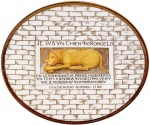 Assiette Goss à l'eff
Assiette Goss à l'eff
igie du Chien d... -
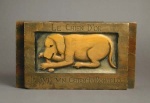 Boîte à cigares repré
Boîte à cigares repré
sentant la lége... -
 Caroline de Saint-Cas
Caroline de Saint-Cas
tin (à droite)... -
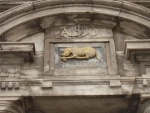 Chien d'or sur l'édi
Chien d'or sur l'édi
fice Louis-S.-S...
-
 Couverture du livre «
Couverture du livre «
Le Chien d'or. ... -
 Couverture du livre «
Couverture du livre «
The golden dog ... -
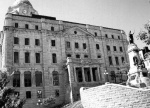 Édifice Louis-S.-St-L
Édifice Louis-S.-St-L
aurent, façade ... -
 Enseigne de la galeri
Enseigne de la galeri
e d'art Le Chie...
-
 Golden Dog - 1987
Golden Dog - 1987
-
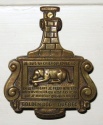 Heurtoir de porte à l
Heurtoir de porte à l
'effigie du Chi... -
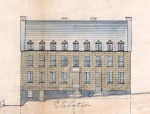 La maison du chien d’
La maison du chien d’
or en 1845, des... -
 Le bas-relief du chie
Le bas-relief du chie
n d’or à Québec...
-
 Le chien d'or - Québ
Le chien d'or - Québ
ec (carte posta... -
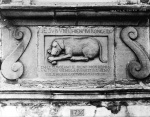 Le Chien d'Or, sous l
Le Chien d'Or, sous l
'entrée princip... -
 Le chien qui ronge l’
Le chien qui ronge l’
os de Pézenas... -
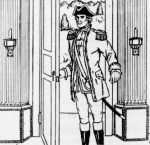 Le colonel Philibert,
Le colonel Philibert,
sous la plume ...
-
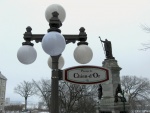 Le passage du Chien-d
Le passage du Chien-d
’Or à Québec, 2... -
 Maison du chien d'or,
Maison du chien d'or,
Québec (carte... -
 Ouvrage «The House of
Ouvrage «The House of
the Golden Dog... -
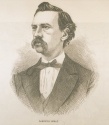 Pamphile Le May en 18
Pamphile Le May en 18
73, portrait pa...
-
 Pamphile Lemay
Pamphile Lemay
-
 Pamphile Lemay (1837-
Pamphile Lemay (1837-
1918) -
 Pamphile Lemay vers 1
Pamphile Lemay vers 1
910 -
 Partition musicale de
Partition musicale de
The Golden Dog...
-
 Photo tirée du dossie
Photo tirée du dossie
r «William Kirb... -
 Photographie du spect
Photographie du spect
acle Le mystèr... -
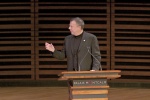 Photographie du spect
Photographie du spect
acle Le mystèr... -
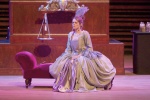 Photographie du spect
Photographie du spect
acle Le mystèr...
-
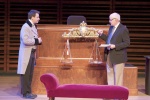 Photographie du spect
Photographie du spect
acle Le mystèr... -
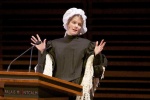 Photographie du spect
Photographie du spect
acle Le mystèr... -
 Portrait de William K
Portrait de William K
irby tel qu'il... -
 Première édition du r
Première édition du r
oman The Golden...
-
 Publicité pour le gin
Publicité pour le gin
de Kuyper, par... -
 Quartier Vieux-Québe
Quartier Vieux-Québe
c - Côte de la... -
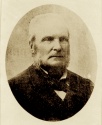 William Kirby, auteur
William Kirby, auteur
du «Golden Dog...
Document PDF
Hyperliens
- Plaque du Chien d'Or sur le site du Répertoire du patrimoine culturel du Québec
- Tribunal de l'Histoire - Le mystère du Chien d'Or (montage vidéo, 3:52)
- Geneviève Lenoir - La Légende du chien d'Or (clip musical, 3:22)
- William Kirby – Dictionary of Canadian Biography Online

